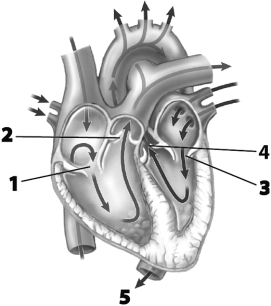Correct Answer

verified
Correct Answer
verified
True/False
An increase in afterload will cause the heart to remain longer in the period of isovolumetric relaxation.
Correct Answer

verified
Correct Answer
verified
True/False
Stroke volume is inversely correlated to preload; i.e., a lower preload increases stroke volume.
Correct Answer

verified
Correct Answer
verified
Multiple Choice
At rapid heart rates
A) systole and diastole shorten equally
B) systole stays almost constant, but diastole shortens
C) systole lengthens and diastole shortens
D) diastole lengthens and systole shortens
E) none of the above occur
Correct Answer

verified
Correct Answer
verified
Short Answer
An increase in parasympathetic activity ____________________ the stroke volume.
Correct Answer

verified
Correct Answer
verified
Short Answer
Use the following answer code to indicate which factor involved in the initiation and spread of cardiac excitation is being identified a.SA node b.AV node c.bundle of His and Purkinje system d.gap junctions -Normal pacemaker of the heart
Correct Answer

verified
Correct Answer
verified
Short Answer
An increase in cardiac sympathetic activity ____________________ the velocity of impulse conduction through the heart.
Correct Answer

verified
Correct Answer
verified
Multiple Choice
The primary function of the pericardial sac is to
A) prevent excessive expansion of the heart as it fills with blood
B) secrete a fluid that reduces friction as the heart beats
C) serve as a reservoir for blood to be used during strenuous exercise
D) provide oxygen and nutrients to the heart muscle
E) catch and kill any bacteria in the blood flowing through the heart chambers
Correct Answer

verified
Correct Answer
verified
Multiple Choice
Vasodilation of coronary arteries is induced by
A) adenosine
B) nitroglycerin
C) nitric oxide
D) all of the above
E) only a and b
Correct Answer

verified
Correct Answer
verified
Multiple Choice
The cardiac output is equal to
A) (EDV - ESV) x HR
B) heart rate x EDV
C) the difference between the stroke volume at rest and the stroke volume during exercise
D) the stroke volume minus the ESV
E) heart rate x blood pressure
Correct Answer

verified
Correct Answer
verified
Short Answer
Using the following answer code, indicate which pressure relationship exists during the time in question. a.aortic pressure > ventricular pressure > atrial pressure b.aortic pressure > ventricular pressure < atrial pressure c.aortic pressure < ventricular pressure > atrial pressure d.aortic pressure < ventricular pressure < atrial pressure -When ventricular ejection is occurring
Correct Answer

verified
Correct Answer
verified
Short Answer
Match EKG feature with the correct characteristic. a.P wave b.QRS complex c.T wave d.PR interval e.TP interval f.ST segment -Time during which atria are repolarizing
Correct Answer

verified
Correct Answer
verified
Multiple Choice
Which of the following is not occurring at the same time when the QRS complex appears on an ECG?
A) depolarization of Purkinje fibers
B) depolarization of the ventricles
C) repolarization of the atria
D) depolarization of internodal pathways
E) All of the above are occurring at the same time
Correct Answer

verified
Correct Answer
verified
Multiple Choice
An ectopic focus is the place where
A) an abnormally excitable area of the heart initiates a premature action potential
B) all of the electrical impulses of the heart terminate normally
C) an ECG lead is attached on the outside of the chest
D) a heart valve is attached
E) the chordae tendineae attach to a valve
Correct Answer

verified
Correct Answer
verified
Short Answer
Use the following answer code to indicate which factor involved in the initiation and spread of cardiac excitation is being identified a.SA node b.AV node c.bundle of His and Purkinje system d.gap junctions -Rapidly conducts the impulse down the ventricular septum and throughout much of the ventricular musculature
Correct Answer

verified
Correct Answer
verified
Short Answer
 Use this figure to answer the corresponding questions.
-The structure labeled 1
a.allows blood to pass into the ventricle
b.has deoxygenated blood flowing past it
c.is connected to chordae tendineae
d.all of these
e.none of these
Use this figure to answer the corresponding questions.
-The structure labeled 1
a.allows blood to pass into the ventricle
b.has deoxygenated blood flowing past it
c.is connected to chordae tendineae
d.all of these
e.none of these
Correct Answer

verified
Correct Answer
verified
True/False
The Frank-Starling law of the heart relates to how stretching of the ventricles during ventricular filling will affect stroke volume.
Correct Answer

verified
Correct Answer
verified
Multiple Choice
A heart valve opens and closes due to
A) being pulled by the heart muscle
B) pressure differences on the valve's two sides
C) Na+ and K+ fluxes during ventricular depolarization
D) turbulent flow in the atria and ventricles
E) none of the above
Correct Answer

verified
Correct Answer
verified
Multiple Choice
If stroke volume is 80 ml and the heart rate is 70 beats per minute, the cardiac output is
A) 150 ml/min
B) 560 ml/min
C) 5,600 ml/min
D) 8,700 ml/min
E) none of the above
Correct Answer

verified
Correct Answer
verified
True/False
The average resting heart rate is normally established by the rhythm of autorhythmic cells located near the base of the right atrium.
Correct Answer

verified
Correct Answer
verified
Showing 61 - 80 of 300
Related Exams